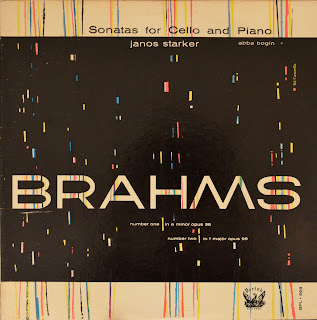Thursday, May 31, 2012
Janos Starker and Abba Bogin: Brahms Sonatas for Piano and Cello, 1951
Today's pick is an earlier effort by the brilliant cellist Janos Starker, a duo recording with pianist Abba Bogin comprised of both of Brahms's Sonatas for Piano and Cello. Bogin was a highly accomplished pianist but may have been best known as the president of the Bohemians, a musicians' club in New York that has been operating since 1907. He died last August a widely respected musical figure. The cover was done by a print maker and sculptor named Ed Casarella. He is fondly remembered here. The music on this album is mostly somber and brooding and also quite technically demanding, but of course the musicians handle the challenges masterfully as they draw out the music's richness. Brahms is noted for exploring new forms while staying more true than most of his Romantic period contemporaries to baroque counterpoint roots. Stylistically speaking, these pieces are no exception, and even inexperienced listeners such as myself can hear the mix of old and relatively new woven carefully and seamlessly together.
In 1833, Johannes Brahms was born in Germany into a middle class (one might say petite bourgeoisie?) family that owned an inn. He initially learned music from his father and at the age of 10, he played a concert to raise money for his own musical education. As a child, he also played music at social events like dances to supplement his family's income. One of his earliest meaningful musical encounters was his acquaintanceship with Eduard Remenyi, a Hungarian violinist who moved to Germany after being banished from Austria. The exact date of their meeting seems disputed with wikipedia placing it as early as 1848 while others (whose information I suspect is more reliable) say they did not meet until 1850. Remenyi had to leave Austria because of his contributions to the separatist Hungarian Revolution of 1848, an independence movement that many Hungarians see as one of the most significant steps towards the formation of the modern Hungarian nation-state. The Hungarian folk forms that Remenyi introduced Brahms to would have a profound impression on the young man for years to come, and the two toured together in 1853. (NB: In light of Brahms's connection with Remenyi, it seems like more than a coincidence that Starker, a musician who dedicated so much of his genius to performing the music of Hungarian composers, would return to these Sonatas to perform and rerecord them at various times throughout his career.) That same year, the Hungarian composer Franz Liszt became interested in Brahms and tried to take him under his wing but Brahms felt too constrained by Liszt's style. 1853 proved a major year for Brahms's entry into the social world of European music as it was also the year that met the immensely popular Schumanns, with whom he shared a deep mutual admiration. He remained close, lifelong friends with Clara after her troubled husband Robert's death in 1856. Throughout his life, Brahms treated the compositional process with a sense of deep gravity and often destroyed all copies of his pieces that did not satisfy his standards. As he approached death in the 1890's, his musical output slowed dramatically in terms of its volume, but many critics maintain that some of his compositions from this period are among his most creative.
Subscribe to:
Post Comments (Atom)

This comment has been removed by the author.
ReplyDeleteThanks!
ReplyDeleteThe B side is silent. Can you double-check please?
ReplyDeleteHere is the new link:
ReplyDeletehttp://www.mediafire.com/?8y77xill65wgq78
Thanks for the heads up, I've been having software trouble lately.
Thanks again - LesTP
ReplyDeleteSe eyxaristo poly
ReplyDelete